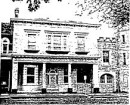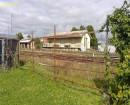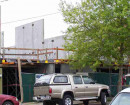PORTER PREFABRICATED IRON STORE
FAIRFIELD PARK, YARRA BEND ROAD FAIRFIELD AND 111 QUEENS PARADE FITZROY NORTH, YARRA CITY
-
Add to tour
You must log in to do that.
-
Share
-
Shortlist place
You must log in to do that.
- Download report



















Statement of Significance
-
-
PORTER PREFABRICATED IRON STORE - History
[From nomination report by Kaye Oddie and a chapter on J H Porter from Miles Lewis's proposed publication on portable buildings.]
Prefabricated iron buildings were manufactured in England from 1848 and in Birmingham from 1850. John Henderson Porter had a long history of manufacturing iron products, and was the first man to hold himself out on any scale as a prefabricator of corrugated iron buildings (Lewis, p 17.1). In 1853 he entered a short-lived partnership, known as Porter Brothers & Stuart, which appeared to have operated from 1854 to 1856. This appears to date the Fitzroy building to that period. Porter buildings imported to Australia include warehouses, stores and schools.
The original location and owner of the iron building in Fitzroy is not known. It was most likely relocated to its present location, given that some of the corrugated iron panels have been trimmed to fit. Local knowledge suggests that it has been on its present site since at least 1944, and that it was moved there from Camp Pell in Royal Park. (Camp Pell was a large military camp established in Royal Park during World War II. The site is now covered with netball/basketball facilities and the new hockey stadium which will be used for the 2006 Commonwealth games.)
The building is now located in Yarra Council's municipal depot and is used for storage. The south wall of the building has been replaced with a wire mesh gate for easy access, and the window above the west doorway has been replaced.
PORTER PREFABRICATED IRON STORE - Assessment Against Criteria
a. Importance to the course, or pattern, of Victoria's cultural history
The Porter prefabricated iron store is a now rare example of the many prefabricated iron buildings which were imported into Victoria during the Victorian gold rushes. It is a reflection of the economic and social conditions in the early 1850s, when there was a great increase in population and a rush of labour to the goldfields, and both labour and building materials were scarce.
b. Possession of uncommon, rare or endangered aspects of Victoria's cultural history.
The Porter prefabricated iron store is a now rare example of the early use of galvanised corrugated iron for the manufacture of prefabricated buildings, and of the prefabrication system of the major English manufacturer J H Porter. Most of the early manufacturers of corrugated iron buildings were British, and J H Porter was an early innovator of such buildings, and probably the first prefabricator. The Porter prefabricated iron store is the only known surviving example in Victoria of a prefabricated iron building manufactured by J H Porter which is still standing.
c. Potential to yield information that will contribute to an understanding of Victoria's cultural history.
d. Importance in demonstrating the principal characteristics of a class of cultural places or environments.
The Porter prefabricated iron store is an early example of the use of a building material, galvanised corrugated iron, which was to become closely linked with Australian building, especially for utilitarian buildings. It is an example of a prefabricated structure with an arched roof, a form with which the English manufacturer J H Porter is particularly associated.
e. Importance in exhibiting particular aesthetic characteristics.
f. Importance in demonstrating a high degree of creative or technical achievement at a particular period.
g. Strong or special association with a particular community or cultural group for social, cultural or spiritual reasons. This includes the significance of a place to Indigenous peoples as part of their continuing and developing cultural traditions.
h. Special association with the life or works of a person, or group of persons, of importance in Victoria's history.
PORTER PREFABRICATED IRON STORE - Plaque Citation
Made in Birmingham c1853 by the major manufacturer J H Porter, this is a now rare example of the many prefabricated buildings brought to Victoria during the gold rushes, and is one of only two known Porter buildings to survive.
PORTER PREFABRICATED IRON STORE - Permit Exemptions
General Exemptions:General exemptions apply to all places and objects included in the Victorian Heritage Register (VHR). General exemptions have been designed to allow everyday activities, maintenance and changes to your property, which don’t harm its cultural heritage significance, to proceed without the need to obtain approvals under the Heritage Act 2017.Places of worship: In some circumstances, you can alter a place of worship to accommodate religious practices without a permit, but you must notify the Executive Director of Heritage Victoria before you start the works or activities at least 20 business days before the works or activities are to commence.Subdivision/consolidation: Permit exemptions exist for some subdivisions and consolidations. If the subdivision or consolidation is in accordance with a planning permit granted under Part 4 of the Planning and Environment Act 1987 and the application for the planning permit was referred to the Executive Director of Heritage Victoria as a determining referral authority, a permit is not required.Specific exemptions may also apply to your registered place or object. If applicable, these are listed below. Specific exemptions are tailored to the conservation and management needs of an individual registered place or object and set out works and activities that are exempt from the requirements of a permit. Specific exemptions prevail if they conflict with general exemptions. Find out more about heritage permit exemptions here.Specific Exemptions:General Conditions: 1. All exempted alterations are to be planned and carried out in a manner which prevents damage to the fabric of the registered place or object. General Conditions: 2. Should it become apparent during further inspection or the carrying out of works that original or previously hidden or inaccessible details of the place or object are revealed which relate to the significance of the place or object, then the exemption covering such works shall cease and Heritage Victoria shall be notified as soon as possible. General Conditions: 3. If there is a conservation policy and plan endorsed by the Executive Director, all works shall be in accordance with it. Note: The existence of a Conservation Management Plan or a Heritage Action Plan endorsed by the Executive Director, Heritage Victoria provides guidance for the management of the heritage values associated with the site. It may not be necessary to obtain a heritage permit for certain works specified in the management plan. General Conditions: 4. Nothing in this determination prevents the Executive Director from amending or rescinding all or any of the permit exemptions. Minor Works : Note: Any Minor Works that in the opinion of the Executive Director will not adversely affect the heritage significance of the place may be exempt from the permit requirements of the Heritage Act. A person proposing to undertake minor works may submit a proposal to the Executive Director. If the Executive Director is satisfied that the proposed works will not adversely affect the heritage values of the site, the applicant may be exempted from the requirement to obtain a heritage permit. If an applicant is uncertain whether a heritage permit is required, it is recommended that the permits co-ordinator be contacted.PORTER PREFABRICATED IRON STORE - Permit Exemption Policy
The purpose of the Permit Policy is to assist when considering or making decisions regarding proposed works. It is recommended that any proposed works be discussed with an officer of Heritage Victoria prior to a permit application. Discussing any proposed works will assist in answering any questions the owner may have and aid any decisions made.
The significance of the object lies in its rarity and intactness as the only known surviving example still standing of a prefabricated corrugated iron building made by the major English manufacturer J H Porter. Any alterations that impact on its significance are subject to permit application.
The store is in good condition, and is currently (March 2010) at the Yarra Council Municipal Depot at 111 Queens Parade, North Fitzroy, where it is used as a storage shed. It is a prefabricated building, originally designed to be moved, and although its early history is unknown, it is thought that it was moved to this site from elsewhere. It therefore has no close association with this particular site, and it would be possible for it to be moved to another site if necessary. A permit would be required for its relocation and is only likely to be granted in conjunction with its re-erection.
Permit exemptions will only be granted where the owner with responsibility for the registered heritage object has developed a Conservation Management Policy [CMP] for the object, and that CMP has been endorsed by the Executive Director. Once an endorsed CMP has been implemented, the object type may be subject to a review to enable a class of standard, or specific, permit exemptions to be granted.
-
-
-
-
-
SHOT TOWER
 Victorian Heritage Register H0709
Victorian Heritage Register H0709 -
CLIFTON HILL PRIMARY SCHOOL
 Victorian Heritage Register H1621
Victorian Heritage Register H1621 -
BELMONT
 Victorian Heritage Register H0871
Victorian Heritage Register H0871
-
..esterville
 Yarra City
Yarra City -
1 Alfred Crescent
 Yarra City
Yarra City -
1 Barkly Street
 Yarra City
Yarra City
-
-
Tours involving this place See all tours
13/09/16
Old Colonists Homes - Former North Fitzroy Post Office - Former North Fitzroy Electric Railway Substation - Former United Kingdom Hotel - Anz Bank - York House - Fitzroy Cricket Ground Grandstand - Porter Prefabricated Iron Store
Public contributions
Tours involving this place See all tours
13/09/16
Old Colonists Homes - Former North Fitzroy Post Office - Former North Fitzroy Electric Railway Substation - Former United Kingdom Hotel - Anz Bank - York House - Fitzroy Cricket Ground Grandstand - Porter Prefabricated Iron Store












